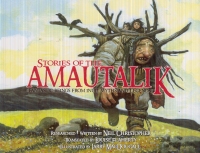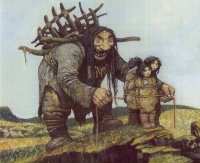| ________________
CM . . .
. Volume XVI Number 23. . . .February 19, 2010 
 |
Stories of the Amautalik: Fantastic Beings from Inuit Myths and Legends.
Neil Christopher. Illustrated by Larry MacDougall. Translated by Louise Flaherty.
Iqaluit, NU: Inhabit Media, 2009.
44 pp., pbk., $4.95.
ISBN 978-0-9782186-3-8.
Subject Headings:
Inuit-Folklore.
Legends-Arctic regions.
Grades 2-5 / Ages 7-10.
Review by Gregory Bryan.
***½ / 4
|
| |
|

excerpt:
Hungry and tired, the ogress decided to follow the sound, hoping it would lead her to something she could eat. From far away, the huge creature spotted the three children. The amautalik's eyes widened and she began to growl with excitement. She had not eaten in many days, and the sight of the children playing made her mouth water.
Researched and written by Neil Christopher, Stories of the Amautalik: Fantastic Beings from Inuit Myths and Legends contains two traditional Inuit stories about child-eating ogresses. In his introductory comments, Christopher writes that, in Inuit mythology, Amautaliit (the plural form of Amautalik) are ogresses who abduct children for food or for entertainment as play-things. The huge, ugly hags live in underground lairs. They are strong and fast, but not very intelligent, and so they can be tricked or outwitted by those unfortunate enough to be captured.
 After a brief introduction, the book contains two illustrated stories and a cautionary end note. In addition to English, the book has also been presented in an Inuktitut version (Inuktitut is one of the official languages of Nunavut). The first story in the book, "The Hungry Amautalik & the Restless Children," originated in the Kivalliq region of Nunavut. The second story is entitled "The Orphan & the Amautalik." This story comes from the Netsilik region. In both cases, the captured children are able to escape their captor. In the first instance, the escape is made with the help of a magical amulet that turns into a snow bunting and, in the second situation, the children escape by tricking the amautalik into thinking that she, herself, is about to fall victim to a monster. After a brief introduction, the book contains two illustrated stories and a cautionary end note. In addition to English, the book has also been presented in an Inuktitut version (Inuktitut is one of the official languages of Nunavut). The first story in the book, "The Hungry Amautalik & the Restless Children," originated in the Kivalliq region of Nunavut. The second story is entitled "The Orphan & the Amautalik." This story comes from the Netsilik region. In both cases, the captured children are able to escape their captor. In the first instance, the escape is made with the help of a magical amulet that turns into a snow bunting and, in the second situation, the children escape by tricking the amautalik into thinking that she, herself, is about to fall victim to a monster.
Despite different cultural origins, there is much about amautaliit that is recognizable. I was reminded of childhood stories that I heard of the Boogeyman or even the Big Bad Wolf. The Inuit presumably shared tales of amautaliit as a means of protecting children from danger. We learn that even "the naughtiest children can be made to stop crying at the mere mention" of the ogresses' name. In the second story, the hungry amautalik hopes to find "children who had disobeyed their parents and wandered too far from their village." The stories teach children to behave or fall victim to an amautalik.
In both stories, the hero protagonist is a child who is picked on and ostracized by other children. In the first story, Kunaju is one of the smallest girls in her village. When Kunaju's mother falls seriously ill, Kunaju's parents leave the village to seek out a healer. Although she is staying with her grandmother, Kunaju becomes somewhat of an orphan. The clever hero of the second story, Aviuq, is an orphan. Like Kunaju, he is often teased and bullied because he has no parents to protect him.
The danger amautaliit represent to naughty children, and the value and good sense of humble, bullied children, is unmistakably intended to teach the reader/listener life lessons about obedience and respect for all. Yet the stories do not come across as preachy or distractingly didactic. Even in a non-Inuit context, the stories still work extremely well because they are interesting and well told. The book echoes the strongest of good story-telling traditions.
Larry MacDougall's illustrations provide appropriately horrible, fearful depictions of the two amautaliit featured in the stories. The text and illustrations complement one another very well to portray the monster and the challenging Arctic setting. MacDougall's drab palette conveys a feeling of danger and dread.
It would be nice to see more illustrations than the relatively few that do appear because those that are provided work well and add to the book. I would also like to see the book published with a hard cover. I recognize that such additions would add greatly to publishing and purchasing costs, but I think that Christopher and MacDougall's work is of such quality that it deserves to be able to compete on an equal playing field with books from the larger publishing houses. Inhabit Media is an Inuit-owned publishing company based on Baffin Island. Established in 2007, with books like Stories of the Amautalik, Inhabit Media looks to be an exciting new face in Canadian children's literature.
Highly Recommended.
Gregory Bryan teaches literacy education and children's literature classes in the Faculty of Education at the University of Manitoba.

To comment
on this title or this review, send mail to cm@umanitoba.ca.
Copyright © the Manitoba Library Association. Reproduction for personal
use is permitted only if this copyright notice is maintained. Any
other reproduction is prohibited without permission.
NEXT REVIEW |
TABLE OF CONTENTS FOR THIS ISSUE
- February 19, 2010.
AUTHORS |
TITLES |
MEDIA REVIEWS |
PROFILES |
BACK ISSUES |
SEARCH |
CMARCHIVE |
HOME |

 After a brief introduction, the book contains two illustrated stories and a cautionary end note. In addition to English, the book has also been presented in an Inuktitut version (Inuktitut is one of the official languages of Nunavut). The first story in the book, "The Hungry Amautalik & the Restless Children," originated in the Kivalliq region of Nunavut. The second story is entitled "The Orphan & the Amautalik." This story comes from the Netsilik region. In both cases, the captured children are able to escape their captor. In the first instance, the escape is made with the help of a magical amulet that turns into a snow bunting and, in the second situation, the children escape by tricking the amautalik into thinking that she, herself, is about to fall victim to a monster.
After a brief introduction, the book contains two illustrated stories and a cautionary end note. In addition to English, the book has also been presented in an Inuktitut version (Inuktitut is one of the official languages of Nunavut). The first story in the book, "The Hungry Amautalik & the Restless Children," originated in the Kivalliq region of Nunavut. The second story is entitled "The Orphan & the Amautalik." This story comes from the Netsilik region. In both cases, the captured children are able to escape their captor. In the first instance, the escape is made with the help of a magical amulet that turns into a snow bunting and, in the second situation, the children escape by tricking the amautalik into thinking that she, herself, is about to fall victim to a monster.